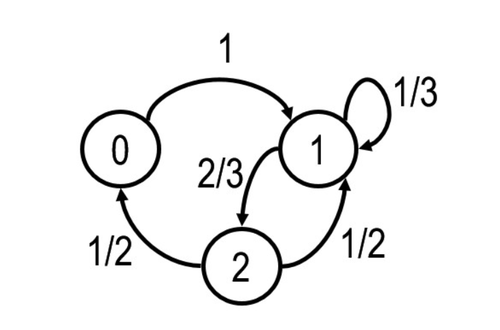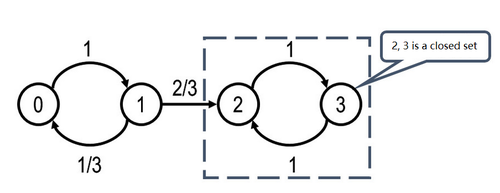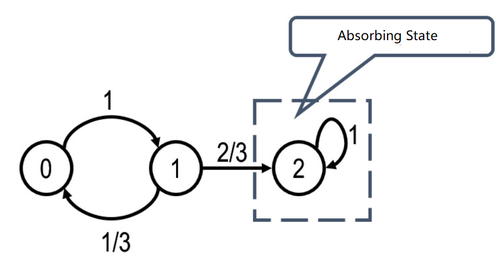(Created page with "Category:Walther MA271 Fall2020 topic2 =Communication and Reducibility= Before moving on and discovering more behaviors of Markov chains, we need to classify the propert...") |
|||
| Line 5: | Line 5: | ||
Before moving on and discovering more behaviors of Markov chains, we need to classify the properties of states first. In the previous section, we use <math>P_{ij}</math> to represent the transition probability of state changing from <math>i</math> to <math>j</math>; now, we use <math>P_{ij}^{n}</math> to denote the transition probability of state changing from <math>i</math> to <math>j</math> after <math>n</math> step. If <math>P_{ij}^{n} \geq 0</math> for all <math>n \geq 1</math>, we say state <math>j</math> is accessible from state <math>i</math>, which also can be written as <math>i \rightarrow j</math>. If <math>i \rightarrow j</math> and at the same time <math>j \rightarrow i</math>, then we say that state <math>i</math> and state <math>j</math> communicate, which can be denoted as <math>i \leftrightarrow j</math>. On the other hand, if <math>P_{ij}^{n} = 0</math> or <math>P_{ji}^{n} = 0</math>, or if both of them come into existence, we claim that state <math>i</math> and state <math>j</math> do not communicate. The diagrams below illustrate these two cases. | Before moving on and discovering more behaviors of Markov chains, we need to classify the properties of states first. In the previous section, we use <math>P_{ij}</math> to represent the transition probability of state changing from <math>i</math> to <math>j</math>; now, we use <math>P_{ij}^{n}</math> to denote the transition probability of state changing from <math>i</math> to <math>j</math> after <math>n</math> step. If <math>P_{ij}^{n} \geq 0</math> for all <math>n \geq 1</math>, we say state <math>j</math> is accessible from state <math>i</math>, which also can be written as <math>i \rightarrow j</math>. If <math>i \rightarrow j</math> and at the same time <math>j \rightarrow i</math>, then we say that state <math>i</math> and state <math>j</math> communicate, which can be denoted as <math>i \leftrightarrow j</math>. On the other hand, if <math>P_{ij}^{n} = 0</math> or <math>P_{ji}^{n} = 0</math>, or if both of them come into existence, we claim that state <math>i</math> and state <math>j</math> do not communicate. The diagrams below illustrate these two cases. | ||
| − | <center[[File:Markovcommunicate.png|500px|thumbnail]]</center> | + | <center>[[File:Markovcommunicate.png|500px|thumbnail]]</center> |
| − | <center[[File:Irreduciblemarkov.png|500px|thumbnail]]</center> | + | <center>[[File:Irreduciblemarkov.png|500px|thumbnail]]</center> |
| − | <center[[File:reduciblemarkov1.png|500px|thumbnail]]</center> | + | <center>[[File:reduciblemarkov1.png|500px|thumbnail]]</center> |
| − | <center[[File:reduciblemarkov2.png|500px|thumbnail]]</center> | + | <center>[[File:reduciblemarkov2.png|500px|thumbnail]]</center> |
[[ Walther MA271 Fall2020 topic2|Back to Markov Chains]] | [[ Walther MA271 Fall2020 topic2|Back to Markov Chains]] | ||
[[Category:MA271Fall2020Walther]] | [[Category:MA271Fall2020Walther]] | ||
Revision as of 00:13, 6 December 2020
Communication and Reducibility
Before moving on and discovering more behaviors of Markov chains, we need to classify the properties of states first. In the previous section, we use $ P_{ij} $ to represent the transition probability of state changing from $ i $ to $ j $; now, we use $ P_{ij}^{n} $ to denote the transition probability of state changing from $ i $ to $ j $ after $ n $ step. If $ P_{ij}^{n} \geq 0 $ for all $ n \geq 1 $, we say state $ j $ is accessible from state $ i $, which also can be written as $ i \rightarrow j $. If $ i \rightarrow j $ and at the same time $ j \rightarrow i $, then we say that state $ i $ and state $ j $ communicate, which can be denoted as $ i \leftrightarrow j $. On the other hand, if $ P_{ij}^{n} = 0 $ or $ P_{ji}^{n} = 0 $, or if both of them come into existence, we claim that state $ i $ and state $ j $ do not communicate. The diagrams below illustrate these two cases.





